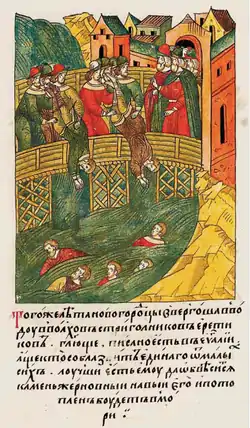Strigolniki
The Strigolniki (singular Strigólnik– Стригольник in Russian) were followers of the first Russian heretical sect of the middle of the 14th and first half of the 15th century, established in Pskov and later in Novgorod and Tver.[1]

The origins of the name remain unclear. Some historians believe it has something to do with handicrafts that the first Strigolniki were engaged in, such as cloth-cutting or hairdressing (it appears that the word strigolnik derives from the Russian root strig-, which connotes cutting or trimming. Others think the name comes from a special initiation ceremony (a specific haircut, or strizhka), performed by a deacon named Karp – a supposed founder of the sect (together with deacon Nikita) yet others think it could mean that these people refused to either grow a beard or cut their beards when they entered churches.
Active participants of the sect were tradespeople and low-ranking clergy. They renounced all ecclesiastic hierarchy and monasticism, sacraments of priesthood, communion, repentance, and baptism, which had been accompanied by large fees ("extortions", in their view) to the benefit of the clergy. Criticizing and exposing the venality, vices, and ignorance of the priests, the Strigolniki demanded the right to a religious sermon for laymen. Their sermons were full of social motifs: they reproached the rich for enslaving the free and the poor.
Deacon Karp found many followers in Pskov, but had to move to Novgorod to avoid persecution. Some scholars argue that Archbishop of Novgorod Vasilii Kalika (1330–1352) ignored the heresy, but that his successors, Moisei (1325–1330; 1352–1359), and Aleksei (1359–1388) took firm measures against the heretics. In 1375, enraged citizens of Novgorod threw three heretics from the bridge into the Volkhov River.[2] Beginning in 1382, the sect was opposed by Archbishop Dionysios of Suzdal.
However, the teachings of the Strigolniki lived on. They spread widely in Novgorod, in Pskov, and also in Tver, where bishops Feodor Dobry and Yevfimiy Vislen came forward with support for the movement. In the early 15th century Photius, Metropolitan of Kiev and all Russia, denounced the Strigolniki teachings.[3]
There has been no record of the sect since the second half of the 15th century. Some historians believe that it merged with the Sect of Skhariya the Jew. The Orthodox Church believes the heresy ended in 1427.
References
- B. A. Rybakov, Strigolniki: Russkie Gumanisty XIV Stoletiia (Moscow: Nauk, 1993); David M Goldfrank, "Burn, Baby, Burn: Popular Culture and Heresy in Late Medieval Russia," The Journal of Popular Culture 31, no. 4 (1998): 17–32.
- Some scholars see this as an execution after the heretics were condemned by Archbishop Aleskei (r. 1359–1388), but others see it as a lynching. See B. A. Rybakov, Strigolniki, 4-11.
- N. A. Kazakova and Ia. S. Lur'e, Antifeodal'nye ereticheskie dvizheniia na Rusi XIV-nachala XVI veka (Moscow and Leningrad, ANSSSR, 1955), esp. pp. 34-71.